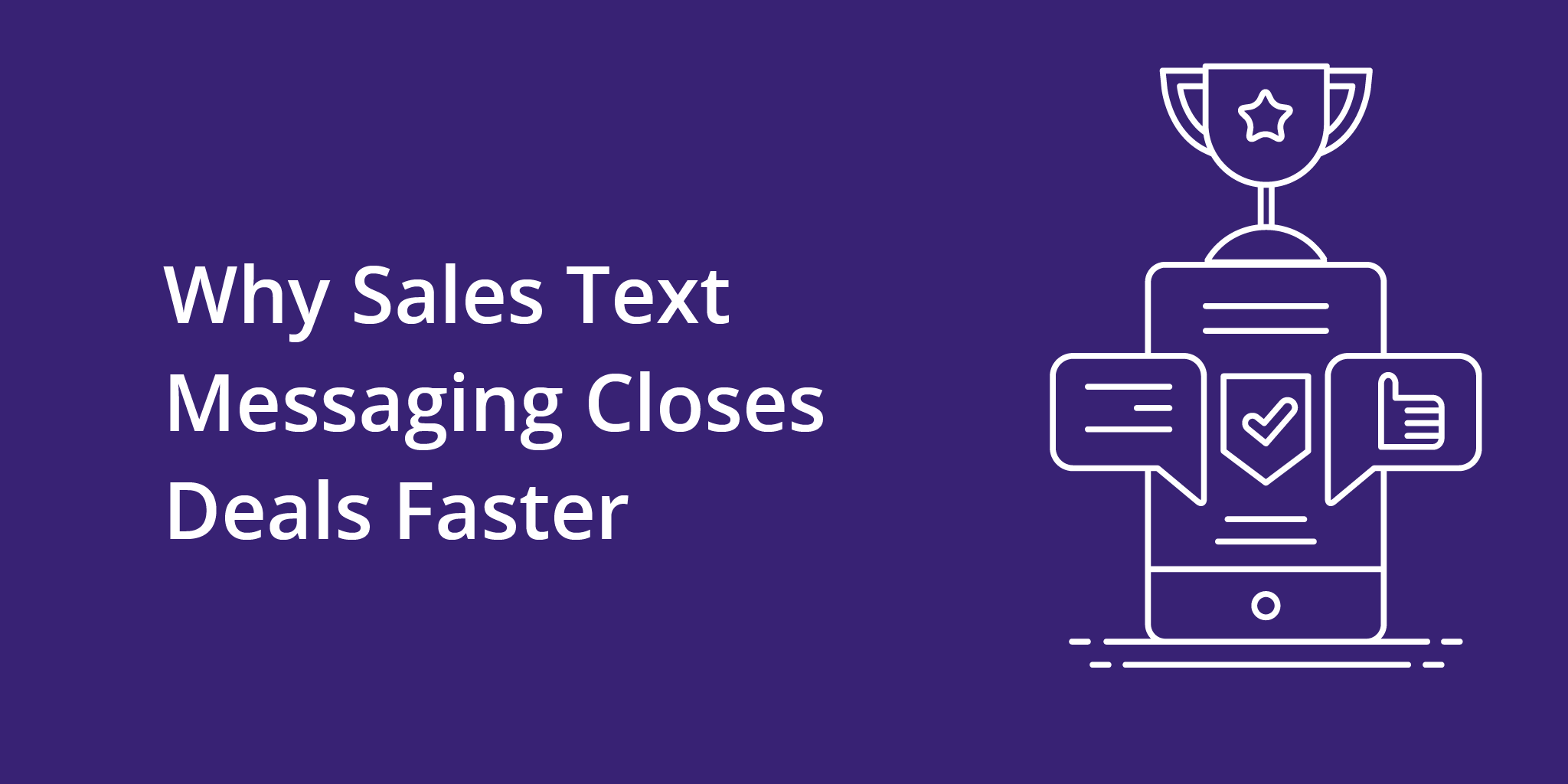With so many varied ways of communicating these days, it can be tricky to figure out the best method for contacting prospects. Email, text messages, phone calls, and live chat are all common ways to reach prospective clients.
The stats behind using SMS for your sales message are impressive. Open rates for text messages are as high as 98% whereas just 22% of emails are opened. 90% of text messages are read within 3 minutes of receipt and business texting has a whopping 209% higher response rate than Facebook, email, or voice messages.
If you want to up your sales figures, adding text messaging to your communication repertoire is a must. That’s not to say every line of your pitch and chatting with prospects needs to be delivered by SMS. Balance and personalized messaging will always be important in sales.

Why is Text Messaging Important in Sales?
It can be difficult to pique a prospect’s interest and keep them engaged. Timing emails perfectly or calling at the precise moment prospects are ready to listen can be a game of chance. One of the best ways to reach prospective clients where they are is with business texting.
A sales message via SMS cuts through the noise. It’s more personal and direct, so it’s much more likely to be read and responded to. SMS works best when mixed with other forms of communication. Business texting services can help blend SMS with email.
When cultivating sales leads, combining email and SMS marketing is a great strategy. If someone wants to download something from a website or sign up for news, asking them to agree to particular terms and conditions is fairly common and adding a requirement for texting is easy. SMS software can send an automated follow-up text message after email confirmation to get the conversation moving.
When using business texting for inbound leads, adding a sales follow-up text message in the usual cadence of touchpoints increases engagement. For outbound prospecting, SMS works better in the latter stages of the communication sequence. The best follow-up text messages come after a personal call or email.
Cold prospecting with text messages is against the Telephone Consumer Protection Agency (TCPA) guidance and could land you in hot water. The rules and regulations around SMS marketing are much the same as those for email and other forms of contact with prospects. People must opt-in and if they request to stop receiving texts, this needs to be respected.
Compliant prospecting with text messages examples include obtaining numbers through a website request, requiring numbers for free quotes, and offering free demos or ebooks in exchange for mobile numbers. Always play by the rules.

The Five Most Important Do’s and Don’ts for Business Texting
If you’re planning to add professional text messages to your sales communications, get familiar with the rules and regulations surrounding business texting. Along with the rules, following texting best practices ensures you don’t lose prospects from your pipeline due to over texting.
#1: Ask for permission before sending sales texts
ALWAYS ask for permission before texting prospects. Make sure permission is recorded and aim for a double opt-in by adding a brief line to your first text. Something like “If you want to stop receiving my text messages, reply STOP” should do.
#2: Consider the timing of your SMS
No one wants to receive text messages in the middle of the night. Just like emails, there are good and bad times to send an SMS. If your prospects are in different time zones to you, take time to figure out the difference before sending your sales text message.
#3: Reasons to send a sales text
Further information for prospects are some of the best sales text messages – they add value, reach prospects where they are, and ensure information isn’t lost. If you’re unsure, try a few sample text messages to customers first and watch the results.
Reminders for meetings, confirming details of a call, and following up after a meeting are all great reasons to send a sales text. They can significantly improve your show-up rate for appointments too.
#4: Reasons NOT to send a sales text
If your sales text message isn’t adding value for your prospect, don’t send it. NEVER get passive-aggressive with your professional text message by asking why someone hasn’t responded to your email or ‘check in’ with text after getting no response from several voice messages.
#5: Automate sales follow up text messages
A CRM that integrates with your text messaging software can ensure the customer journey touchpoints never miss a beat and conversations keep moving in the right direction. Automation can enable your sales team to work with more prospects.
Automating texts along with calls and emails allows you to create a customized journey that salespeople can easily follow. This approach makes personalization simple. Key information about the prospect such as name, company, and any other pertinent details can be pulled directly from the CRM and incorporated in the SMS template.

How to Craft the Best Sales Text Messages
Great salespeople personalize their message for each prospect. This helps build rapport and trust. The best sales text messages are the ones that connect with the prospect, so you’ll need to use your own judgment when crafting them. Still, there are some rules you should follow when writing a professional text message.
Remember that you are reaching your prospect right where they are when you send an SMS. Be friendly and personable, but don’t overdo it. Poor punctuation, text-speak like “R U free 2 chat?”, acronyms, and emojis are generally out for business texting. Some B2C brands may encourage a little of this, but be careful not to cross the line and become over-familiar with prospects.
Each SMS should be brief and to the point. Limit yourself to one ask per text. Give compelling reasons why the prospect should answer yes to your request. Finally, show your humanness, be yourself, not a sales-bot!
Text messaging is the most used form of communication in the world, and Americans text twice as much as they call. Well-crafted sales text messages are more likely to reach your prospect than other types of communication.
Getting the Most From Sales Messages With SMS
There are plenty of sales text message examples that have their place in building relationships with prospects – business texting is the preferred method of communication for some people. But while it can be easier to text than call, it shouldn’t make up the entirety of the communication with potential customers.
Adding SMS to your prospect’s journey with automation can ease the load on sales staff and increase the number of deals they close. If you’re not already using sales texts, make this year the year you start.



